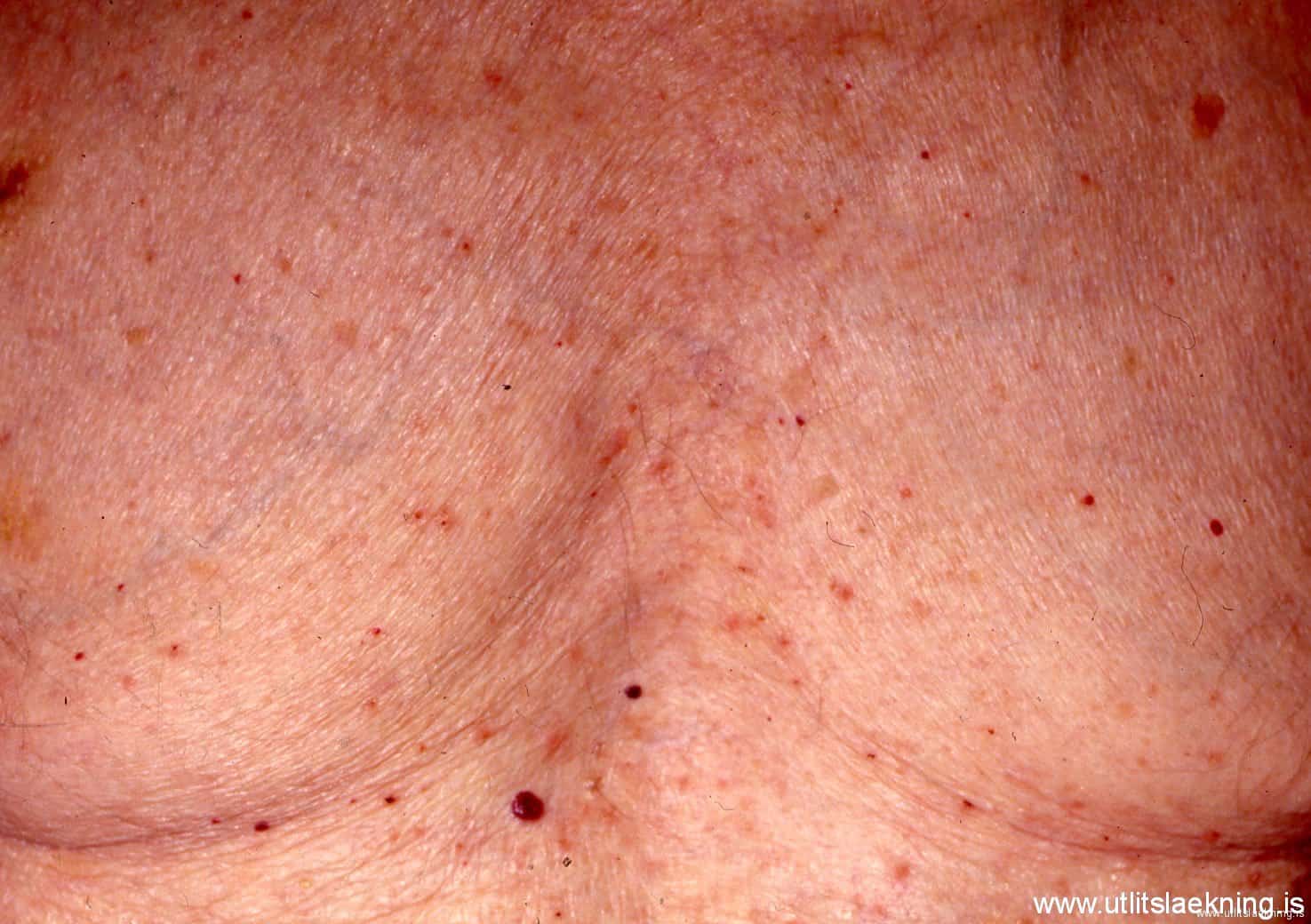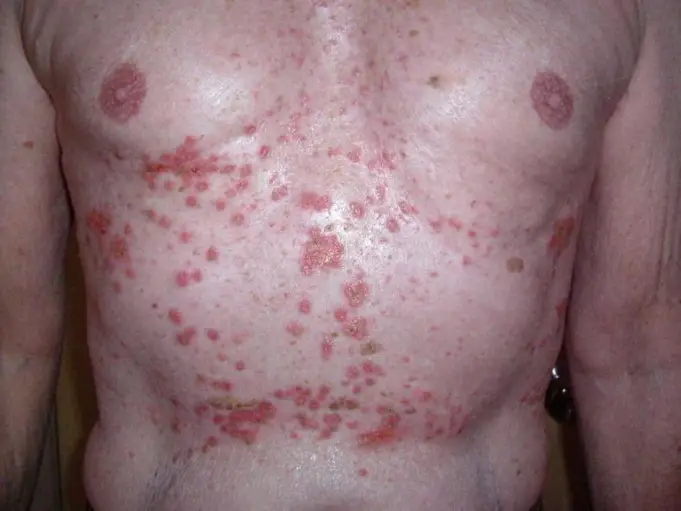Grover’s disease is also known as Transient Acantholytic Dermatosis (TAD) or Persistent Acantholytic Dermatosis (PAD). It is a rare, transitory skin condition that is characterized of tiny, firm, raised red lesions that appear most often in the skin of the chest and back.
Grover’s disease (TAD) is a condition that is not totally known in its origin, it is believed to be an acquired pruritic eruption of small vesicles and erythematous papules.
The etiology and pathogenesis of the glover’s disease is very much unclear but reports states that the disease was first brought to light in 1975 by an American dermatopathologist, Ralph Wier Grover (1908-2008).
Ralph Grover discovered the skin condition while working at the Franklin Hospital in New York; he described and examined a total of 40 patients presenting signs of the disease, which later inherited his name- Grover’s disease.
The condition mostly leads to intense itching, although it may be asymptomatic (causing no symptoms), the condition persists for longer periods but in few cases, it is transient that lasts an average of 10 to 12 months.
The statistics for existing cases of Grover’s disease and the number of new cases over time have not been firmly established. A study in Switzerland, diagnosed Grover’s disease in 24 of more than 30,000 skin biopsies.
The condition was discovered to be mostly common in middle-aged white men, although other ages, genders and ethnic groups may be affected.
Causes of Grover’s Disease
Grover’s disease and its prognosis (development) is still not clear to clinicians, because of these uncertainties, some thinks Grover’s disease to be an allergic rash reaction to substances and due to its risk factor; affecting middle aged men, individuals have defined this medical skin disorder, as an onset or introduction to middle-aged crisis for men.
The causes of TAD are unknown, sometimes it follows sweating and unexpected heat stress; Dermatologists have microscopically observed dried skin cells in order to understand the disease more.
The outermost layer of the skin is called the ‘horny layer’. Individuals with Grover’s disease have been seen to possess an abnormal horny layer that disrupts how the skin cells is attached to each other. When the skin cells detach (lysis), it forms bumps or blisters.
Other clinicians have correlated that it might be due to sweat and sweat ducts dysfunction, but contrary to this, the condition also arises in dry skins. Many affected individuals are sun damaged and so it may be damages on the sweat duct caused by prolonged exposure of the skin to the sun.
Other triggers to Grover’s disease activity may include ionizing radiation, adverse reaction to medications, end-stage renal hemodialysis and mechanical irritation or prolonged bed rest.
One series of report entails details of 300 patients with Grover’s disease associated with other coexisting dermatoses including contact dermatitis, xerosis cutis and atopic dermatitis.
Finally, a smaller discovery has detailed an association with pyoderma gangrenosum, bacterial and viral infections and occasionally, mallgnancies.
Risk Factors of Grover’s Disease
Grover’s disease (TAD) is a very rare skin condition occurring mainly in males between the ages 40 to 50. Though females and younger people are likely to get it too (less common), it is common with individuals who may be suffering from other ailments in some way or a reaction to a particular medication.
Grover’s disease has been reported in some cases to be in association with several medications, such as:
- Cetuximab
- Mercury
- D-penicillamine
- Anastrozole
- Ribavirin
- Vemurafenib
- Dabrafenib
- Interleukin-4
Signs and Symptoms of Grover’s Disease
Grover’s disease often begins suddenly with major symptoms including:
- Sudden rash on the chest, back and lesser times legs and arms
- Blisters clumped together in groups, surrounded by a red swollen ring.
- Intense Itching, which progresses gradually, although not everyone experiences itching.
- Blisters containing a thin, watery liquid with hair follicle in the center.
Diagnosis of Grover’s Disease
Grover’s disease can be diagnosed by a dermatologist; this is a clinician/doctor that specializes in the skin and skin conditions. Individuals mostly visit a dermatologist when itching becomes intense or rash appears.
It is easy for most dermatologists to diagnose Grover’s disease based on physical examinations of the skin. In other to confirm diagnosis, a skin biopsy might be conducted; it involves the shaving of the skin samples and viewing under the microscope.
Differential Diagnosis for Grover’s Disease

Some few other skin conditions may present similar symptoms with Grover’s disease. Comparisons by clinicians and individuals may be useful for a differential diagnosis:
- Dermatitis herpetiformis (Dh) is an uncommon skin disorder occurring in ages of 15 to 60 years old. Clustered blisters and firm spots (papules) may occur on the skin of the extensor areas (knees, elbows, pelvis, buttocks and skull), face and neck. Itching and burning may be severe. Immunoglobulin A (IgA; antibodies found in saliva, tears and sweat) is found in almost all normal or blistered skin of patients having this condition. The exact cause of Dh is unknown.
- Pemphigus is another group of rare skin abnormality characterized by blisters in the epidermis (outer layer of the skin) and within mucous membranes (the thin moist lining of the body’s internal surfaces). The location and outlook of the blisters varies according to the type of pemphigus. Blisters are common in all types and these blisters may be soft or hard. Blisters form due to separation of closely connected tissues in the epidermis (acantholysis). Most patients with this condition have increased IgG (Immunoglobulin G; an antibody in the blood that defends against foreign bodies) in the blood and in areas of the blisters. IgG may attack normal skin cells while attacking foreign bodies located at the surface of particular skin.
- Darier disease is a slow progressive, hereditary skin disorder. It possesses features of elevated spots (papules) on the scalp, forehead, face, neck, area behind the ears and middle of the back. Gradual burning and itching occur, and the spots become larger, darker and may be covered with grey/brown scales or crusts. This skin condition is gradually progressive and tends to become more severe with exposure to sunshine and/or emotional stress. Darier disease is inherited as a dominant trait.
Treatment of Grover’s Disease
Grover’s disease is quite difficult to treat in some patients; some patients may be affected once, and the condition may respond readily to standard treatments. For others, Grover’s disease may recur several times and require long-term therapy or the use of more potent medications.
If mild rash appears or in situations of minor outbreak that may not itch or is confined to a small area of the body, the first treatments may include:
- Antihistamines; administered orally.
- Prescription cortisone cream applied to the rash.
- Other anti-rash lotions that contain menthol or camphor
Larger outbreaks that involve itching and may cover the entire trunk of the body, presenting severe symptoms can typically be treated using retinoids (such as acitretin or isotretinoin) or an antibiotic taken by the moth (orally) as prescribed by the doctor.
But these drugs may cause important side effects, so it is always advised to seek and follow doctors’ instructions and not self medicate.
If these conventional treatments approach does not work, it means the patients have a more severe case of Grover’s disease that needs further treatment.
Treatment for severe cases includes:
- Antifungal medication
- Cortisone injections
- Oral corticosteroids
- PUVA phototherapy
- Topical application of selenium sulfide
PUVA phototherapy treatment technique used for severe cases of Grover’s disease is often used on psoriasis. First, the patient is given psoralen pills, which makes the skin more sensitive to ultraviolet light. Then he/she is placed in a light box to undergo UV radiation.
The treatment is conducted twice or three times per week for roughly 12 weeks.
Summary
Keep cool, wear garments designed to prevent sweat rash to avoid any chances of Grover’s rash. The duration of Grover’s disease (TAD) is variable- from months to years. It may be transitory and often varies with season.
Individuals are medically advised/suggest reducing activities that can cause prolonged sweating (like heavy duty workouts), since sweating worsens the rash, more baths and showers and less amount of time in the sun.
Make sure to contact a dermatologist early as it is the key to ensuring your symptoms are cleared up and don’t resurface.
Sources;
- Monolateral Grover’s Disease; http://pubmed.ncbi.nlm.nih.gov/30064609/
- Transient acantholytic dermatosis; http://dermnetnz.org/topics/transient-acantholytic-dermatosis/
- Grover’s disease; http://rarediseases.info.nih.gov/diseases/6551/grovers-disease#panelContentOverview
- Treatment for Grover’s Disease; http://newsnetwork.mayoclinic.org/discussion/treatment-for-grovers-disease-geared-toward-relieving-itching-and-rash/












